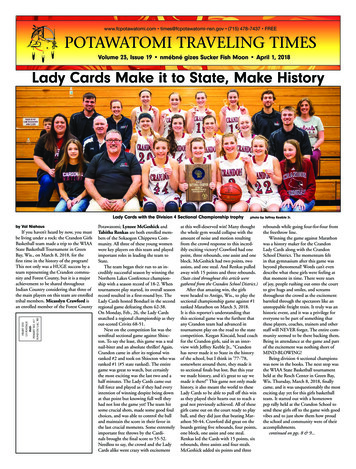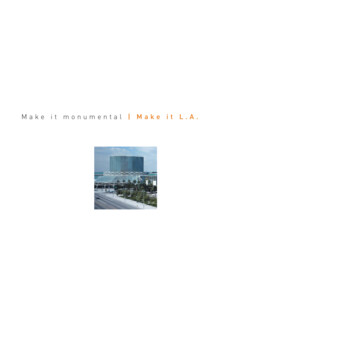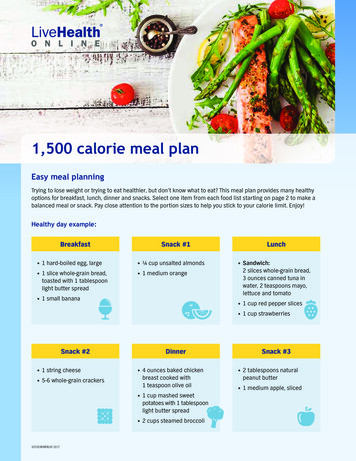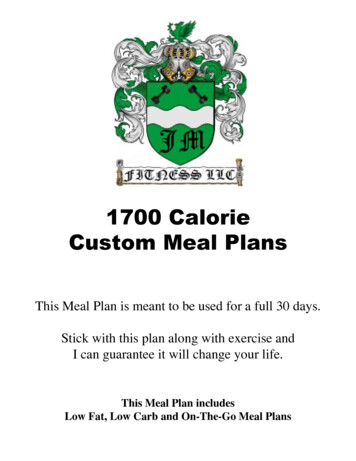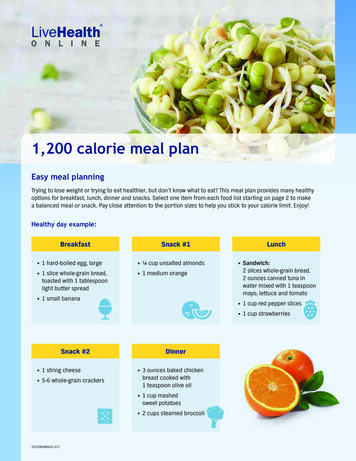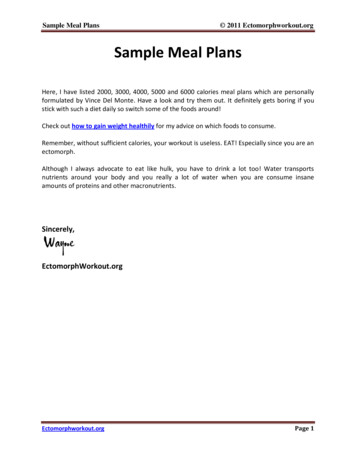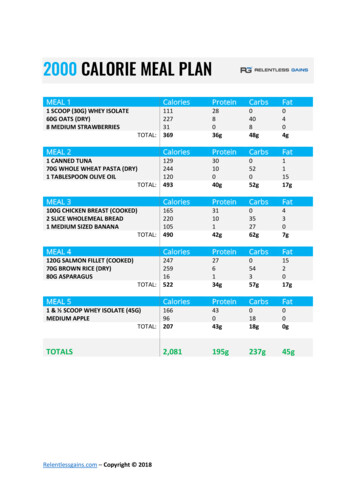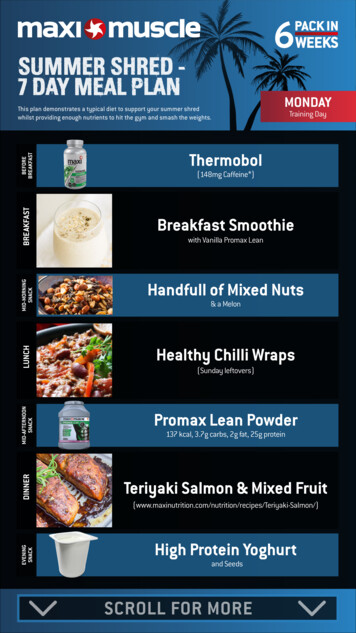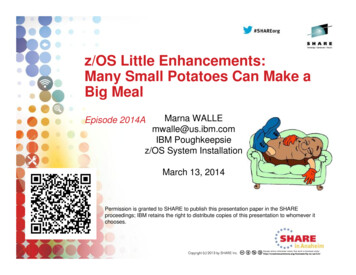
Transcription
z/OS Little Enhancements:Many Small Potatoes Can Make aBig MealMarna WALLEmwalle@us.ibm.comIBM Poughkeepsiez/OS System InstallationEpisode 2014AMarch 13, 2014Permission is granted to SHARE to publish this presentation paper in the SHAREproceedings; IBM retains the right to distribute copies of this presentation to whomever itchooses.
TrademarksThe following are trademarks of the International Business Machines Corporation in the United States, other countries, or both.Not all common law marks used by IBM are listed on this page. Failure of a mark to appear does not mean that IBM does not use the mark nor does it mean that the product is notactively marketed or is not significant within its relevant market.Those trademarks followed by are registered trademarks of IBM in the United States; all others are trademarks or common law marks of IBM in the United States.For a complete list of IBM Trademarks, see www.ibm.com/legal/copytrade.shtml:*, AS/400 , e business(logo) , DBE, ESCO, eServer, FICON, IBM , IBM (logo) , iSeries , MVS, OS/390 , pSeries , RS/6000 , S/30, VM/ESA , VSE/ESA,WebSphere , xSeries , z/OS , zSeries , z/VM , System i, System i5, System p, System p5, System x, System z, System z9 , BladeCenter The following are trademarks or registered trademarks of other companies.Adobe, the Adobe logo, PostScript, and the PostScript logo are either registered trademarks or trademarks of Adobe Systems Incorporated in the United States, and/or other countries.Cell Broadband Engine is a trademark of Sony Computer Entertainment, Inc. in the United States, other countries, or both and is used under license therefrom.Java and all Java-based trademarks are trademarks of Sun Microsystems, Inc. in the United States, other countries, or both.Microsoft, Windows, Windows NT, and the Windows logo are trademarks of Microsoft Corporation in the United States, other countries, or both.Intel, Intel logo, Intel Inside, Intel Inside logo, Intel Centrino, Intel Centrino logo, Celeron, Intel Xeon, Intel SpeedStep, Itanium, and Pentium are trademarks or registered trademarks of IntelCorporation or its subsidiaries in the United States and other countries.UNIX is a registered trademark of The Open Group in the United States and other countries.Linux is a registered trademark of Linus Torvalds in the United States, other countries, or both.ITIL is a registered trademark, and a registered community trademark of the Office of Government Commerce, and is registered in the U.S. Patent and Trademark Office.IT Infrastructure Library is a registered trademark of the Central Computer and Telecommunications Agency, which is now part of the Office of Government Commerce.* All other products may be trademarks or registered trademarks of their respective companies.Notes:Performance is in Internal Throughput Rate (ITR) ratio based on measurements and projections using standard IBM benchmarks in a controlled environment. The actual throughput that any user willexperience will vary depending upon considerations such as the amount of multiprogramming in the user's job stream, the I/O configuration, the storage configuration, and the workload processed.Therefore, no assurance can be given that an individual user will achieve throughput improvements equivalent to the performance ratios stated here.IBM hardware products are manufactured from new parts, or new and serviceable used parts. Regardless, our warranty terms apply.All customer examples cited or described in this presentation are presented as illustrations of the manner in which some customers have used IBM products and the results they may have achieved. Actualenvironmental costs and performance characteristics will vary depending on individual customer configurations and conditions.This publication was produced in the United States. IBM may not offer the products, services or features discussed in this document in other countries, and the information may be subject to change withoutnotice. Consult your local IBM business contact for information on the product or services available in your area.All statements regarding IBM's future direction and intent are subject to change or withdrawal without notice, and represent goals and objectives only.Information about non-IBM products is obtained from the manufacturers of those products or their published announcements. IBM has not tested those products and cannot confirm the performance,compatibility, or any other claims related to non-IBM products. Questions on the capabilities of non-IBM products should be addressed to the suppliers of those products.Prices subject to change without notice. Contact your IBM representative or Business Partner for the most current pricing in your geography.Notice Regarding Specialty Engines (e.g., zIIPs, zAAPs and IFLs):Any information contained in this document regarding Specialty Engines ("SEs") and SE eligible workloads provides only general descriptions of thetypes and portions of workloads that are eligible for execution on Specialty Engines (e.g., zIIPs, zAAPs, and IFLs). IBM authorizes customers to useIBM SE only to execute the processing of Eligible Workloads of specific Programs expressly authorized by IBM as specified in the “Authorized UseTable for IBM Machines” provided at www.ibm.com/systems/support/machine warranties/machine code/aut.html (“AUT”).No other workload processing is authorized for execution on an SE.IBM offers SEs at a lower price than General Processors/Central Processors because customers are authorized to use SEs only to process certaintypes and/or amounts of workloads as specified by IBM in the AUT.2Episode 2014A: z/OS Little Enhancements: Many Small Potatoes Can Make a Big Meal! 2014 IBM Corporation
z/OS Little Enhancements: Many Small Potatoes Can Make a Big Meal ! Everyone, right now: Learning about new content from releases Learning about new content from PTFsz/OS V2.1: BCP: Dynamic SYSDSN ENQ downgrade BCP: Add and remove MCS consoles dynamically BCP: Dynamic system symbol support BCP: DISPLAY PPT BCP: BCP parmlib commentsz/OS V1.13: z/OS UNIX: Non-privileged user mountz/OS V1.12: BCP: Timed Event Data Report – Dig more out of it DFSMS: IDCAMS DELETE All Members, plus more!z/OS V1.11: BCP: DELMIGDS for IEFBR14 Communications Server: syslogd browser and searchOlder than dirt on potatoes: z/OS UNIX: REMOUNT to change the mount mode z/OS UNIX: submit with cron ISPF: Member search commands 3Episode 2014A: z/OS Little Enhancements: Many Small Potatoes Can Make a Big Meal! 2014 IBM Corporation
Everyone, right now! Learning about new content in z/OS releases–IBM Education Assistance 2003 IBMCorporation Scoped PDFs files that cover a single enhancement, or groupof related enhancements. Installation and migration information, includes two MP3recordings from SHARE in Boston 2013. z/OS V2.1 has 113 files for you! Divided into categories of value. Subdivided into elements. Try it out here! IBM z/OS V2.1 Education Assistance z/OS V1.13 IBM Education Assistant information still availablehere: IBM z/OS V1.13 Education Assistant 2007 IBM Corporation Contains PDFs and some MP3s in an InfoCenter format.4Episode 2014A: z/OS Little Enhancements: Many Small Potatoes Can Make a Big Meal! 2014 IBM Corporation
Everyone, right now! Learning about new content in z/OS releases–IBM Education Assistance 2003 IBMCorporation 2007 IBM Corporation5Episode 2014A: z/OS Little Enhancements: Many Small Potatoes Can Make a Big Meal! 2014 IBM Corporation
Everyone, right now! Learning about new content in z/OS stack PTFs–My Notifications 2003 IBMCorporation Receive notification when a z/OS platform APAR has closed. Instructions are found in an ATS Techdoc: ATS TechDoc PRS5188 Signup through IBM Support Portal, new option added for subscription! All z/OS platform new function PTFs will be identified to you.Found through:1. Manage support notifications2. Subscribe3. System z4. z/OS – OS and related Software5. Document type: New Function APARs 2007 IBM Corporation6Episode 2014A: z/OS Little Enhancements: Many Small Potatoes Can Make a Big Meal! 2014 IBM Corporation
Everyone, right now! Learning about new content in z/OS stack PTFsMy Notifications– 2003 IBMCorporationSample email 2007 IBM Corporation7Episode 2014A: z/OS Little Enhancements: Many Small Potatoes Can Make a Big Meal! 2014 IBM Corporation
z/OS V2R1 EnhancementsSmall Enhancements of System Programmer Interest BCP: Dynamic SYSDSN ENQ downgrade BCP: Add and remove MCS consoles dynamically BCP: Dynamic system symbol support BCP: DISPLAY PPT BCP: BCP parmlib comments Sysprog Sysprog & Users8Episode 2014A: z/OS Little Enhancements: Many Small Potatoes Can Make a Big Meal! 20032007IBMIBMCorporationCorporation 2014 IBM Corporation
z/OS V2R1 EnhancementsBCP: Dynamic SYSDSN ENQ downgradeWhat: The ability to allow a SYSDSN enqueue downgrade for batch jobs, whenappropriate. This allows the possibility for better batch parallelism.How to use:– Must coordinate ability between JES2 JOBCLASS attribute DSENQSHR andJCL JOB keyword DSENQSHR. Defaults to off. – JES2 JOBCLASS attribute: DSENQSHR AUTO ALLOW DISALLOW– ALLOW allows a downgrade only when JCL has ALLOW– AUTO allows a downgrade when JCL has ALLOW or USEJC– JCL JOB keyword: DSENQSHR ALLOW USEJC DISALLOW– USEJC allows downgrade only when jobclass is AUTO– ALLOW allows a downgrade when JOBCLASS has AUTO or ALLOWConsiderations: – SYSDSN enqueue downgrade occurs once in a job per data set. You can have enqueue downgradesfor different data sets at different steps.– Prior to this enhancement, the exclusive enqueue was held until the end of the job, even if allsubsequent steps were DISP SHR. Review your DISP coding to make sure it is accurate beforeusing this enhancement, and you weren’t relying on prior behavior.– Downgrading the SYSDSN enqueue for one job, may allow other jobs to take advantage of the sharedenqueue without those jobs needing to be updated.9Episode 2014A: z/OS Little Enhancements: Many Small Potatoes Can Make a Big Meal! 2014 IBM Corporation
z/OS V2R1 EnhancementsBCP: Dynamic SYSDSN ENQ downgrade//LONG JOB (accounting),DSENQSHR ALLOW//STEP1 EXEC PGM WHATEVER//NEW DD DSN MY.DATA.SET,DISP NEW//STEP2 EXEC PGM SOMEPGM//OLD DD DSN MY.DATA.SET,DISP MOD//STEP3 EXEC PGM PROGM2//SHRNOW DD DSN MY.DATA.SET,DISP SHR//STEP4 EXEC PGM WRITER//OLDAGAIN DD DSN MY.DATA.SET,DISP OLD//STEP5 EXEC PGM SOWHAT//SHRAGIN DD DSN MY.DATA.SET,DISP SHR//STEP6 EXEC PGM WHOKNOWS//STILLSHR DD DSN MY.DATA.SET,DISP SHRExclusive ENQ,until STEP4 is doneNow, shared ENQ,Other jobs may run//WAITING JOB (accounting)//STEP1 EXEC PGM READER//JUSTSHR DD DSN MY.DATA.SET,DISP SHR //WAITIN2 JOB (accounting)//STEP1 EXEC PGM READER//STEP2 EXEC PGM READ2//STILLSHR DD DSN MY.DATA.SET,DISP SHR //JUSTSHR DD DSN MY.DATA.SET,DISP SHR//STEP2 EXEC PGM READ2//STILLSHR DD DSN MY.DATA.SET,DISP SHR10Episode 2014A: z/OS Little Enhancements: Many Small Potatoes Can Make a Big Meal! 2014 IBM Corporation
z/OS V2R1 EnhancementsBCP: Add and remove MCS consoles dynamicallyWhat: The ability to add and delete consoles without an outage using operatorcommands, when in Distributed mode.How to use:– SET CON xx processes operational settings and creates new consoles found inthat CONSOLxx parmlib member – New SMCS or subsystem consoles will be defined sysplex-wide (even preV2R1)– Cannot add the system console (SYSCON) dynamically– Only specified statements will be processed (absence will not mean default)– SETCON DELETE,CN nnnnnnn deletes that inactive console from the sysplex– Applies to MCS, HMCS, SMCS, Subsystem, as well as, EMCS consoles– Can delete an inactive console from a system that didn’t define it (even preV2R1)Considerations: May choose to replace samplib program IEARELCN (removesinactive EMCS consoles) with SETCON DELETE.– If you decide to use the specified CONSOLxx parmlib members for subsequentIPLs, you’ve hardened the usage of the consoles you added. 11Episode 2014A: z/OS Little Enhancements: Many Small Potatoes Can Make a Big Meal! 2014 IBM Corporation
Example: remove an inactive MCS console, then add it back in.12Episode 2014A: z/OS Little Enhancements: Many Small Potatoes Can Make a Big Meal! 2014 IBM Corporation
z/OS V2R1 EnhancementsBCP: Dynamic system symbol support What: The ability to add or change system symbols in a supported way on a local system.Two new methods are provided to do this: SETLOAD xx,IEASYM and IEASYMU2. How to use: SETLOAD xx,IEASYM “starts fresh and ready for next IPL” : Thisindicates to process the IEASYM statement in LOADxx found in your parmlibconcatenation. (There is a SETLOAD xx,IEASYM,DSNAME dd,VOLUME vv. if you wantto point to a data set outside the parmlib concatenation.)– A new complete system symbol table is built. The prior system symbol table remainsallocated. Therefore, it’s better to do fewer rebuilds than more rebuilds. IEASYMU2 “the accumulator” replaces IEASYMUP. IEASYMU2 is similar to IEASYMUP,in that you can run a batch job to update the system symbols. The same FACILITY classprofile (IEASYMUP.*) is used.– However, IEASYMU2 changes (or a continued use of IEASYMUP, for that matter) willnot be reflected when you do a subsequent SETLOAD xx,IEASYM .– No changes in the limit in the number of system symbols: remains at least 800 symbols.Considerations: Don’t use the old unsupported method (IEASYMUP) anymore.Understand the interactions between SETLOAD xx,IEASYM, IEASYMU2, and IEASYMUP, asyour IEASYMU2 / IEASYMUP changes will be lost when a SETLOAD xx,IEASYM is done.– If you decide to use specified LOADxx parmlib member for subsequent IPLs, you’vehardened the usage the symbols you’ve changed with the SETLOAD xx,IEASYM . 13Episode 2014A: z/OS Little Enhancements: Many Small Potatoes Can Make a Big Meal! 2014 IBM Corporation
z/OS V2R1 EnhancementsBCP: A BONUS system symbol - &SYSOSLVL !! What: A new system-defined symbol to indicate the z/OS release.– The format for z/OS is: Z1vvrrmm– z/OS V2 R1 is: Z1020100 How to use:– Use it as you wish and where allowed to: in data set names, etc. Considerations: If you defined a system symbol to do this yourself, considerusing the system-defined one instead. z/OS defines six for you.14Episode 2014A: z/OS Little Enhancements: Many Small Potatoes Can Make a Big Meal! 2014 IBM Corporation
z/OS V2R1 EnhancementsBCP: DISPLAY PPT What: A new system command to display the currently effective programproperties table (PPT). Including options to show:– ALL: all the entries in the PPT– PARMLIB: entries specified from SCHEDxx– DEFAULT: entries that are IBM-supplied defaults and have not beenre-specified by SCHEDxx– NAME pattern: entries that match a pattern (wildcards accepted) How to use: D PPT or D PPT,options Example:D PPTIEF386I 20.58.57 DISPLAY PPT 837Parmlib ValuesPgmName NC NS PR ST ND BP Key 2P 1P NP NH CPADRDSSU. . . . . Y 8. . . . .AFPS010S . Y . Y Y . 1. . Y . . Default ValuesPgmName NC NS PR ST ND BP Key 2P 1P NP NH CPAPSHPOSE . Y . Y Y . 1. . Y . .APSKAFPD . Y . Y Y . 1. . Y . . ReferenceSynonym NSNon-swappablePRPrivileged 15----SCHEDxx keywNOCANCELNOSWAPPRIVEpisode 2014A: z/OS Little Enhancements: Many Small Potatoes Can Make a Big Meal! 2014 IBM Corporation
z/OS V2R1 EnhancementsBCP: Parmlib comments What: The ability to add comments to certain parmlib members,throughout the member. This allows for better documentation of themember (and can be less error-prone).– Previously, some parmlib members only allowed comments at the endof the line, or at the end of the member, or possibly no comments at all.– For Parmlib members COMMNDxx, GTFPARM, IEAABD00,IEACMD00, IEADMP00, IEADMR00, IEAPAKxx, IEASYSxx,LPALSTxx, VATLSTxx. (IGDSMSxx already supported comments /* */) How to use: Put an asterisk in column 1. That line is ignored. Considerations: With OA38328 back to R12, for parmlib sharing. Example: 16SYS1.PARMLIB.POK(COMMNDMW) - 01.00Command ***** ***************************** Top of Data *********COLS ---- ----1---- ----2---- ----3---- ----4---- ----500001 *00002 * USE MPFLSTAI for MPF TableMarna 7/31/2013 *00003 *00004 COM 'SET MPF AI'***** **************************** Bottom of Data *******Episode 2014A: z/OS Little Enhancements: Many Small Potatoes Can Make a Big Meal! 2014 IBM Corporation
z/OS R13 EnhancementsSmall Enhancements of System Programmer Interest z/OS UNIX: Non-privileged user mount 20032007IBMIBMCorporationCorporation17Episode 2014A: z/OS Little Enhancements: Many Small Potatoes Can Make a Big Meal! 2014 IBM Corporation
z/OS R13 Enhancementsz/OS UNIX: Non-privileged user mount What: SUPERUSER.FILESYS.MOUNT is a user mount option, howeverthere is no verification if the user is allowed to mount or unmount a filesystem at that mount point.– Now, there is a “safer” and “easier” way to allow users to mount theirown file systems.– Only supported with BPX2MNT (mount2) interface (ex. /usr/sbin/mountand TSO MOUNT commands) Considerations: Supported file system types are HFS, zFSand NFS SYSNAME option is not supported NOSECURITY option cannot be specified NOSETUID option must be specified chmount is not supported for nonprivilegedusers Remount is not supported for nonprivilegedusers Use of /// as a file system name placeholder isnot supported BPX1MNT callable service is not supported fornonprivileged users18Episode 2014A: z/OS Little Enhancements: Many Small Potatoes Can Make a Big Meal! 2014 IBM Corporation
z/OS R13 Enhancementsz/OS UNIX: Non-privileged user mount How to mount:– Read access to SUPERUSER.FILESYS.USERMOUNT UNIXPRIV profile– Read-Write-Execute (RWX) access permission to the mount point directory– If Sticky bit is set, then the user must be the owner of mount point directory– Mount point directory must be empty– Read-Write-Execute (RWX) access permission to the file system root directory to mount– If Sticky bit is set, then the user must be the owner of file system root to mount How to unmount: Read access to that UNIXPRIV profile, and be the one that mounted it. System-wide control with the following new keywords in BPXPRMxx:– MAXUSERMOUNTSYS( ):– Use the MAXUSERMOUNTSYS statement to specify the maximum number ofnonprivileged user mounts in the system or in shared file system configuration.– Default is 0 (none).– MAXUSERMOUNTUSER( ):– Use the MAXUSERMOUNTUSER statement to specify the maximum number ofnonprivileged user mounts allowed for any nonprivileged user in the system or inshared file system configuration.– Default is 0 (none).19Episode 2014A: z/OS Little Enhancements: Many Small Potatoes Can Make a Big Meal! 2014 IBM Corporation
z/OS R13 Enhancementsz/OS UNIX: Non-privileged user mount Display non-privileged user mount information using filters– D OMVS,FILE,UID euid USER PRIV D OMVS,F,UID USERfor non-privileged mountsBPXO045I 13.37.38 DISPLAY OMVS 589OMVS000E ACTIVEOMVS (Y2,3Z)TYPENAMEDEVICE ----------STATUS----------- MODE MOUNTEDLATCHESZFS19 ACTIVERDWR 07/22/2010 L 27NAME MYFS1.ZFS13.37.25Q 0PATH /u/myzfs1/mntzfsUID UID 295HFS20 ACTIVERDWR 07/22/2010 L 23NAME MYFS2.HFS13.37.28Q 0PATH /u/myhfs2/mntzfsUID UID 47 D OMVS,F,UID PRIVfor non-privileged mountsBPXO045I 13.38.38 DISPLAY OMVS 592OMVS000E ACTIVEOMVS (Y2,3Z)TYPENAMEDEVICE ----------STATUS----------- MODE MOUNTEDLATCHESZFS3 ACTIVERDWR 07/22/2010 L 15NAME ZOS113.VAR.ZFS nothing12.46.09Q 0PATH /SYSTEM/varZFS2 ACTIVERDWR 07/22/2010 L 14NAME ZOS113.ETC.ZFS12.46.09Q 0ginnothPATH /SYSTEM/etc20Episode 2014A: z/OS Little Enhancements: Many Small Potatoes Can Make a Big Meal! 2014 IBM Corporation
z/OS R13 Enhancementsz/OS UNIX: Non-privileged user mount Display nonprivileged user mount information and settings–DISPLAY OMVS,USERMOUNTSBPXO072I 13.28.20 DISPLAY OMVS 544OMVS000E ACTIVEOMVS (Y2,3Z)NONPRIVILEGED USER MOUNTS SUM
IBM z/OS V2.1 Education Assistance z/OS V1.13 IBM Education Assist ant information still available here: IBM z/OS V1.13 Education Assistant Contains PDFs and some MP3s in an InfoCenter format. 5 Episode 2014A: z/OS Litt
